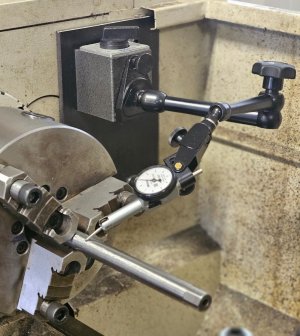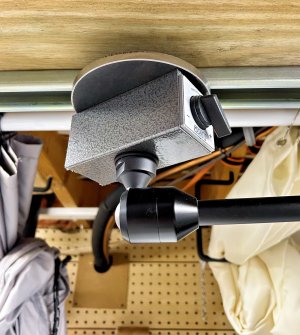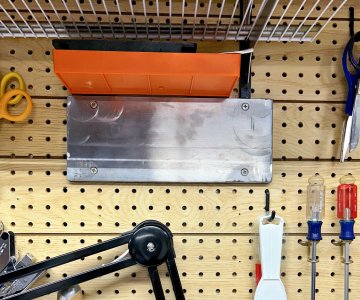Maybe a year ago or so @Dabbler and I were talking about various ways to mount an indicator on a lathe. I have used the normal gammut of methods from putting a mag base on the tool post, on the cross-slide, on the chuck itself, and on the gear box. The problem with the last three is that cast iron has low magnetic permeability. It doesn't hold a magnet as strongly as steel does. Nobody likes a mag base coming loose in the middle of using it.
@Dabbler suggested a piece of solid plate steel attached to the gear box behind the chuck. And so it came to pass that a small project was added to my long list.
A 1/4" thick steel plate provides plenty of magnetic attraction. So some time after that, I acquired a piece of 1/4" steel plate about 10" x 5". I don't even remember where I got it. My plan was to use the two existing M6-1.0 SHCS's holding the backsplash in place on the headstock behind my lathe to mount the plate. I located the screw spacing using transfer screws in the backsplash screw holes to transfer the locations to the back of the plate. Then I drilled the plate holes a wee bit bigger (1/4" vs 6mm) for some wiggle room.
Today I mounted the plate for the first time to test it. It worked GREAT!

This is my medium sized NOGA holder. At some point, I think I'll paint the base plate the same colour as my lathe. But for now it's fine as is.
More importantly, it works great. No need to use the relatively weak permeability of my cross-slide or headstock anymore. I'll still need to use my chuck on occasion and obviously also my toolpost. But this completely eliminates the need to use those marginal surfaces.
A small project, but very useful, and I'm very happy with it.
For anyone who is interested, the ground rod shows about 1.5 thou of runout in my 3 jaw. The end is about 5 thou so there is some concentricity error. But, it's a 3 jaw. I don't really expect better.
@Dabbler suggested a piece of solid plate steel attached to the gear box behind the chuck. And so it came to pass that a small project was added to my long list.
A 1/4" thick steel plate provides plenty of magnetic attraction. So some time after that, I acquired a piece of 1/4" steel plate about 10" x 5". I don't even remember where I got it. My plan was to use the two existing M6-1.0 SHCS's holding the backsplash in place on the headstock behind my lathe to mount the plate. I located the screw spacing using transfer screws in the backsplash screw holes to transfer the locations to the back of the plate. Then I drilled the plate holes a wee bit bigger (1/4" vs 6mm) for some wiggle room.
Today I mounted the plate for the first time to test it. It worked GREAT!

This is my medium sized NOGA holder. At some point, I think I'll paint the base plate the same colour as my lathe. But for now it's fine as is.
More importantly, it works great. No need to use the relatively weak permeability of my cross-slide or headstock anymore. I'll still need to use my chuck on occasion and obviously also my toolpost. But this completely eliminates the need to use those marginal surfaces.
A small project, but very useful, and I'm very happy with it.
For anyone who is interested, the ground rod shows about 1.5 thou of runout in my 3 jaw. The end is about 5 thou so there is some concentricity error. But, it's a 3 jaw. I don't really expect better.



